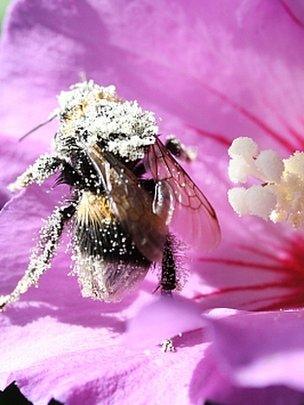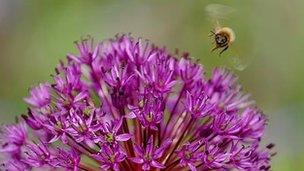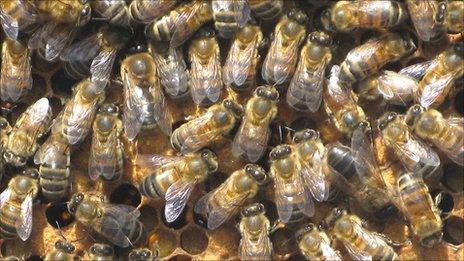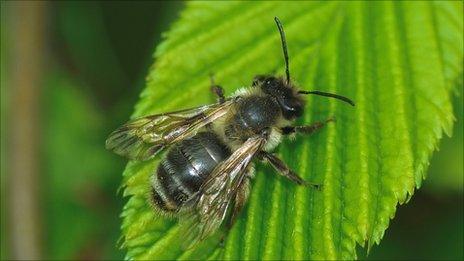Urban areas are hives for wild bees
- Published

The number of wild bee species that were able to adapt to urban habitats surprised the researchers
A study has found a "considerable richness" of wild bee species in most types of urban habitats.
French researchers recorded almost a third of the nation's 900 species of wild bees living in towns and cities.
Writing in Plos One, they added that 60 species were also found in very urbanised areas, external in the city of Lyon.
There is widespread concern that wild bee populations in rural areas are being adversely affected by a number of factors, including pesticides.
"For a bee species to be present in [an urban] habitat, it must be able to find food and nesting substrate," said co-author Laura Fortel, a researcher from the French National Institute for Agricultural Research (INRA).
"Urban and periurban (the transition between rural and urban) sites can provide high quantities of flowers all year long; they show a high diversity of land cover types and are often warmer than surrounding landscapes."
She added: "Also, such habitats are seldom treated with pesticides, which are involved in the decline of bees elsewhere."
City living
The two-year study recorded the number of bee species caught in traps and nets at 24 locations with varying levels of urbanisation - buildings, roads, industrial areas etc - within the Grand Lyon area.
The team collected 12,872 individual wild bees, and recorded 291 different species.
The findings showed that while the overall abundance of bees declined as the level of urbanisation increased, species richness was at its highest in areas of intermediate (50%) urbanisation.

Bees that were able to adapt to urban habitats were the most successful, the study suggested
The team also saw a change in the type of wild bee species that thrived as habitats became more urbanised.
"The structure of the community changed along the urbanisation gradient, with more parasitic species in sites with [an] intermediate proportion of impervious surfaces," they observed.
"There were also greater numbers of cavity-nesting species and long-tongued species in sites with intermediate or higher proportion of impervious surface.
But they added that their findings suggested that the level of urbanisation had no effect on the occurrence of species regarding body size or social behaviour.
Other studies also showed that urban habitats can support a diverse number of wild bee species. A five-year study in Germany's capital city, Berlin, recorded 262 different species, while two studies of 21 urban gardens in New York City observed 110 species of bees.
Ms Fortel concluded: "The presence of a diverse array of bee species even in the most urbanised area make these pollinators worthy of being a flagship group to raise the awareness of urban citizens about biodiversity."
- Published13 August 2013
.jpg)
- Published2 August 2011

- Published22 June 2011
